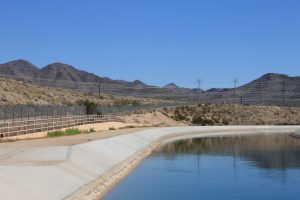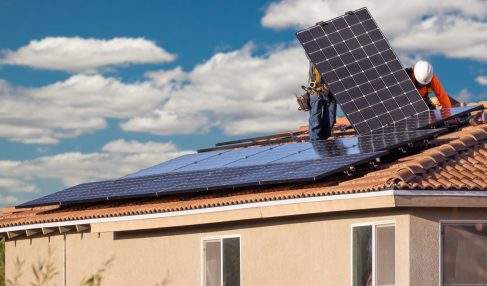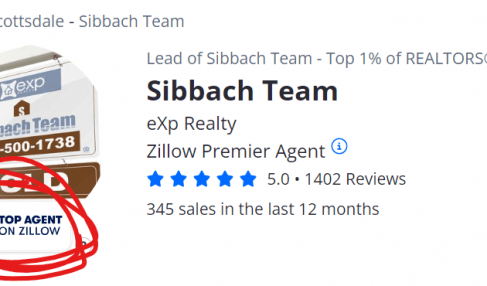 Q: There are 5 “C’s” on the State Seal. What do they mean?
Q: There are 5 “C’s” on the State Seal. What do they mean?
A: The Five C’s on the State Seal stand for: Climate, Cotton, Copper, Cattle and Citrus. When the state was at it’s early stages, Arizona’s economy was leveraged by these five industries.
Q: What are all the canals in North Scottsdale Real Estate for and how do they work?
A: Agriculture and gravity. Really. There are 1,265 miles of canals controlled by the Salt River Project (SRP) that were put built to provide water to Arizona’s crops. Since water flows downhill, this is how the system works. There are a few pumping systems, however the majority of the work is done by gravity. The first canals were dug by the Hohokam Indians about 1,300 years ago to water their crops of beans corn and squash. The same system is used today, and the paths along these canals provide a scenic route for bike riding, walking, and running. But NOT swimming.
Q: Why don’t Arizonan’s practice daylight-saving time?
A: Actually, in 1967 Arizona and North Scottsdale Real Estate used daylight saving to adopt the Uniform Time Act, which was enacted to put the entire nation on one time standard. However, residents tired of an entire summer of their beautiful sunsets coming after 9 p.m., and abandoned the plan. Arizona is one of a few other states, including: Hawaii, Puerto Rico, the Virgin Islands, American Samoa and parts of Indiana that remain attached to Standard Time.
Q: What is the elevation of real estate in Scottsdale, Phoenix and other major cities?
A: All of Arizona is not created equal in terms of elevation. It changes from 70 feet on the Colorado River just South of Yuma, to 12,633 feet at the San Francisco Peaks North of Flagstaff. North Scottsdale Real Estate elevation is 1,117 feet. Carefree’s elevation is 2500 feet. Phoenix: 1,117 feet. Flagstaff: 7,000 feet. Bisbee: 5300 feet. Lake Havasu: 482 feet Grand Canyon: From 2,400 feet to over 7,000. Sedona: 4,400 feet. Greer: 8,525 feet. Tucson: 2,389 feet. Yuma: 145 feet.
Q: Why doesn’t the state of Arizona have a Governor’s mansion?
A: Actually we do. But no governor has lived in it for about 130 years, and it is an historic landmark. Built in 1864, the Governor’s Mansion is a big wood log house in Prescott, AZ, about 1.5 hours outside of North Scottsdale Real Estate. I twas constructed when Prescott was the territorial capital. It was home and office to Arizona’s first two territorial governors, John Goodman, 1863-1866, and Richard McCormick, 1866-1869. During McCormick’s tenure, the territorial capital was moved to Tucson. Later, the capital moved to Phoenix. However a new Governor’s mansion is yet to be built in Phoenix.
Q: What is that white pyramid monument in Papago Park (located on the East edge of the city, between Tempe and North Scottsdale Real Estate)?
A: That white pyramid is called Hunt’s Tomb, named for Arizona’s first governor, George W.P. (Wylie Paul) Hunt. Hunt was also Arizona’s second, third, sixth, seventh, eighth and 10th governor, between 1912 and 1932. Each term was two years. A staunch opponent of the death penalty and a proponent of women’s suffrage, Hunt died in 1934 at age 75 in his Phoenix home. The pyramid holds the remains of Hunt; his wife, Helen; their daughter, Virginia; his sister-in-law, Lena; and his in-laws, Mr. and Mrs. Jessie W. Ellison. And in case you were wondering, according to the State Historic Preservation Office, the pyramid is covered in long-lasting, easy-to-maintain, bathroom-like ceramic tiles.
Q: How does irrigation work, and why do only some areas and neighborhoods offer it?
A: Irrigation is used in some older parts of North Scottsdale Real Estate and the valley by irrigating the water from the canals to water lawns. If you live in SRP’s water district, you get SRP’s irrigated water. That’s why you see berms built up around the lawns which hold in the irrigation water. Irrigation saves money, which is why many parks and some schools are also irrigated.
Q: How far is it to the ocean from North Scottsdale Real Estate?
A: The Sea of Cortez, located in Rocky Point, Mexico contain the nearest beaches and are only about 215 Miles from Phoenix. This border town is about a 4 hour drive, and passports are necessary to cross the border.
Q: What mountains surround Phoenix and North Scottsdale Real Estate?
A: Mountain ranges surround great Phoenix. To the East, you will find the Superstitions just beyond the town of Mesa. The Sierra Estrellas stretch the Southwest. The White Tanks surround the West Valley, and the McDowells are the cause of our amazing views in North Scottsdale Real Estate.
Q: Is it true that people really eat rattlesnake here?
A: Well, yes, and some restaurants even serve it. However, rattlesnake is not a local specialty, it is a local novelty delicacy. Tourists eat it, locals don’t.
Q: Why do Arizona sunsets have such vibrant colors?
A: Some of the reason is our air is fairly clear and clean, as oppose to smoggy. When the sun is low in the sky and the path of the light rays is longer, the yellows and oranges and reds (the ones with longest wavelengths) get scattered around near the ground. Really high clouds also help catch the light. Our great sunsets are not the result of dust in the air as commonly believed.
Q: What does it mean when people say “The Valley?”
A: The nickname of Great Phoenix is “The Valley of the Sun.” It gets this nickname from the surrounding mountains which create a bowl effect for the city.
Q:What are the causes of dust storms? Is there danger?
A: The months of May through September are the most common months for dust storms. They are caused when high winds brush through fields or dry desert landscape. Although brief, dust storms must be taken seriously because they may cause blinding conditions while driving. Dust storms have been attributed to many collisions. There are even times when airlines need to wait out the dust storm before take off or landing. The dust storm itself is not dangerous however, unless winds are so strong they blow down trees, etc. If ever caught in a dust storm while driving, take care as you would in heavy fog.
Q: What is “Monsoon Season?”
A: This is the season, during the summer, when thunderstorms cause the heaviest rains of the year. Temperatures fall rapidly during these storms, and can sometimes take a 10-20 degree drop in temperature. Flash floods are a concern, so stay away from washes, and never drive through blocked roads. These thunderstorms almost always occur in the late afternoon and evening hours.
Q: When does monsoon season start during the summer?
A: The monsoon season starts early to mid July, but sometimes does not start until August. It is considered that monsoon season has begun once we have 3 consecutive days of a dew point of 55 degrees or higher.
Q: What’s the record for the most consecutive days of rain?
A: The Phoenix record for the most sequential days with a hint or more of rain is 14, set in Jan. 5-18, 1993. All in all, 5.12 inches of rain fell over that time.
Q: How many days of sunshine does Phoenix and North Scottsdale Real Estate average each year?
A: Phoenix and North Scottsdale Real Estate average 296 days of sunshine each year.
Q: Does the desert air tend to be good for allergy sufferers and asthmatics?
A: This used to be the case, but nowadays some people move here and their symptoms are worse. This is not because of the native desert vegetation, but because of the imports like olive trees, mulberry trees, and bermuda grass.
Q: What is a Jackalope? Is there really such a thing?
A: Immortalized on a Bob Petley postcard, the novel Jackalope (half bunny, half antelope) is 100% fiction. It was created on a lark in the 1930’s.
Q: Is North Scottsdale Real Estate the wealthiest city in Arizona?
A: No, the most affluent community is considered to be Paradise Valley, which is located between north Phoenix and North Scottsdale Real Estate.
Q: Are there a lot of rattlesnakes?
A: Eleven species of rattlesnakes reside in Arizona. They tend to emerge in the spring, March/April, and during the summer are most active at night. You will see them most in areas where rattlesnake nests are formed. In certain areas they live around homes and neighborhoods, in other areas, a person could live in a home for years without seeing even one. You may run across one while hiking, and they will not strike unless they feel threatened. If you are ever bitten, get help immediately.
Q: Are there a lot of scorpions?
A: Like rattlesnakes, there are many different varieties of scorpions. And, also like rattlesnakes, they tend to nest in certain areas. If your home has a nest nearby, you may see them in your yard, and they may get into your house. There are neighborhoods with homes that have never had a scorpion in or around the home, and there are some with a lot. Especially if there is new construction nearby where scorpion nests have been dug up and they are looking for a new place to nest. They are nocturnal, and like to nest and burrow under rocks, wood piles, etc. So never stick your hand in a crevice without looking first. There is only one scorpion breed, the Bark Scorpions, whose sting is considered life-threatening. If ever stung, take a dose Benedryl immediately.
Q: So, where does the drinking water for Arizona come from?
A: In the years after construction of Roosevelt Dam, a series of five dams – three on the Salt and two on the Verde – were built to help store water from the rivers’ 13,000-square-mile watersheds. Those dams created the various lakes – Canyon, Saguaro, etc.
The water enters the SRP canal system at the Granite Reef Diversion Dam below the confluence of the Salt and Verde in the far East Valley. The snowmelt in the Eastern mountains keeps the lakes filled.
Also, ground pumping delivers Arizona’s share of Colorado River water to Phoenix, North Scottsdale Real Estate, and Tucson.




